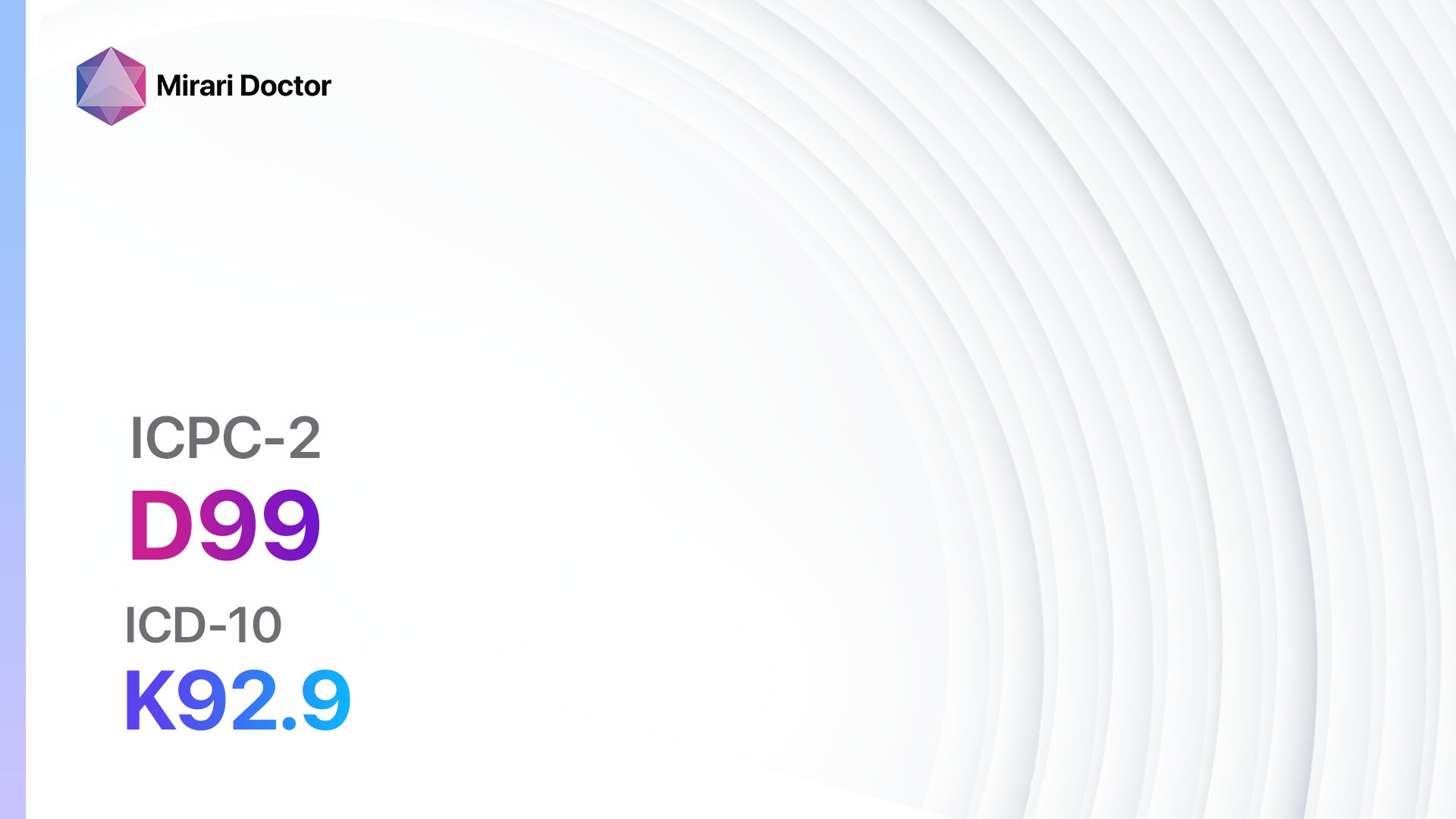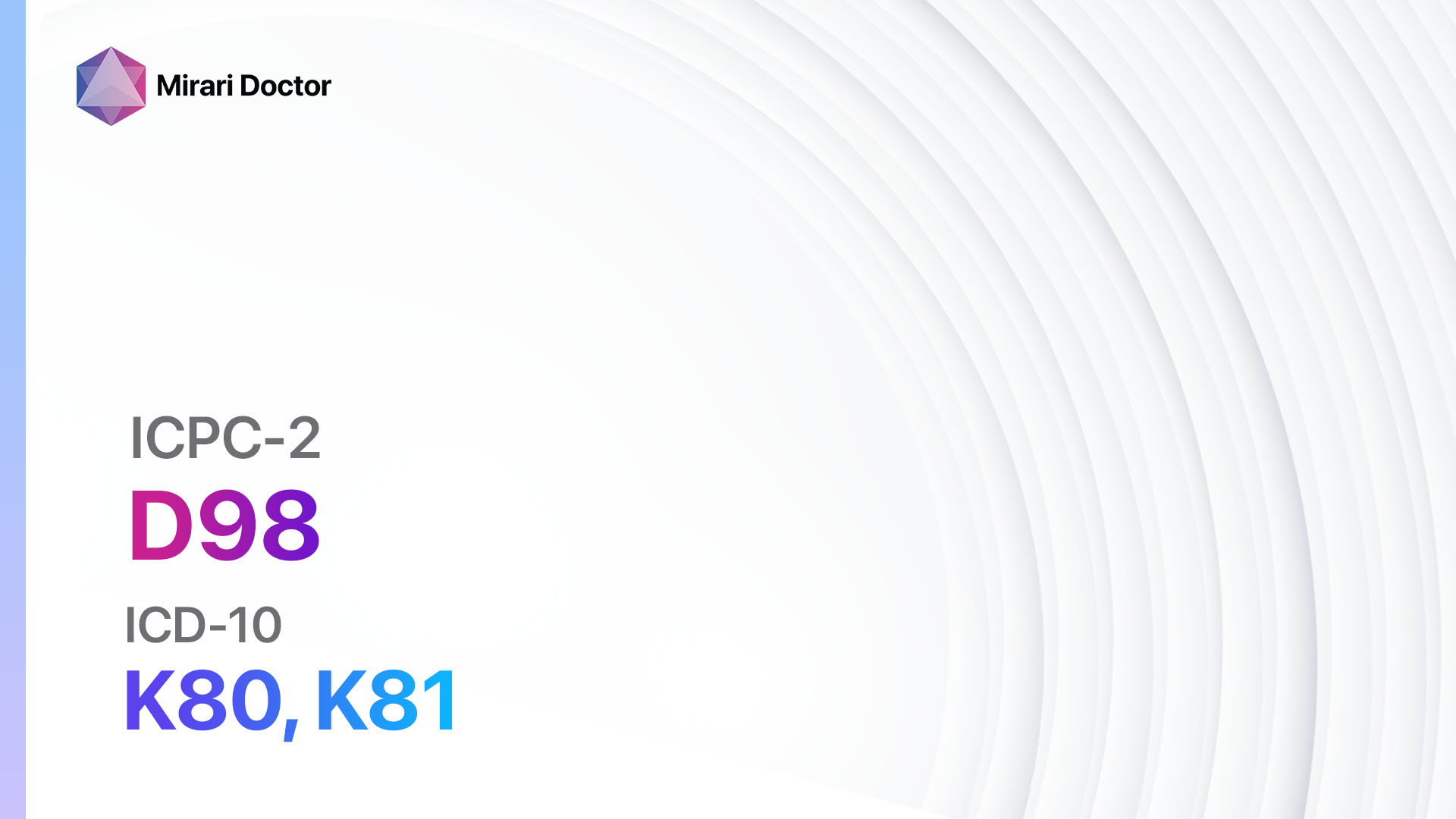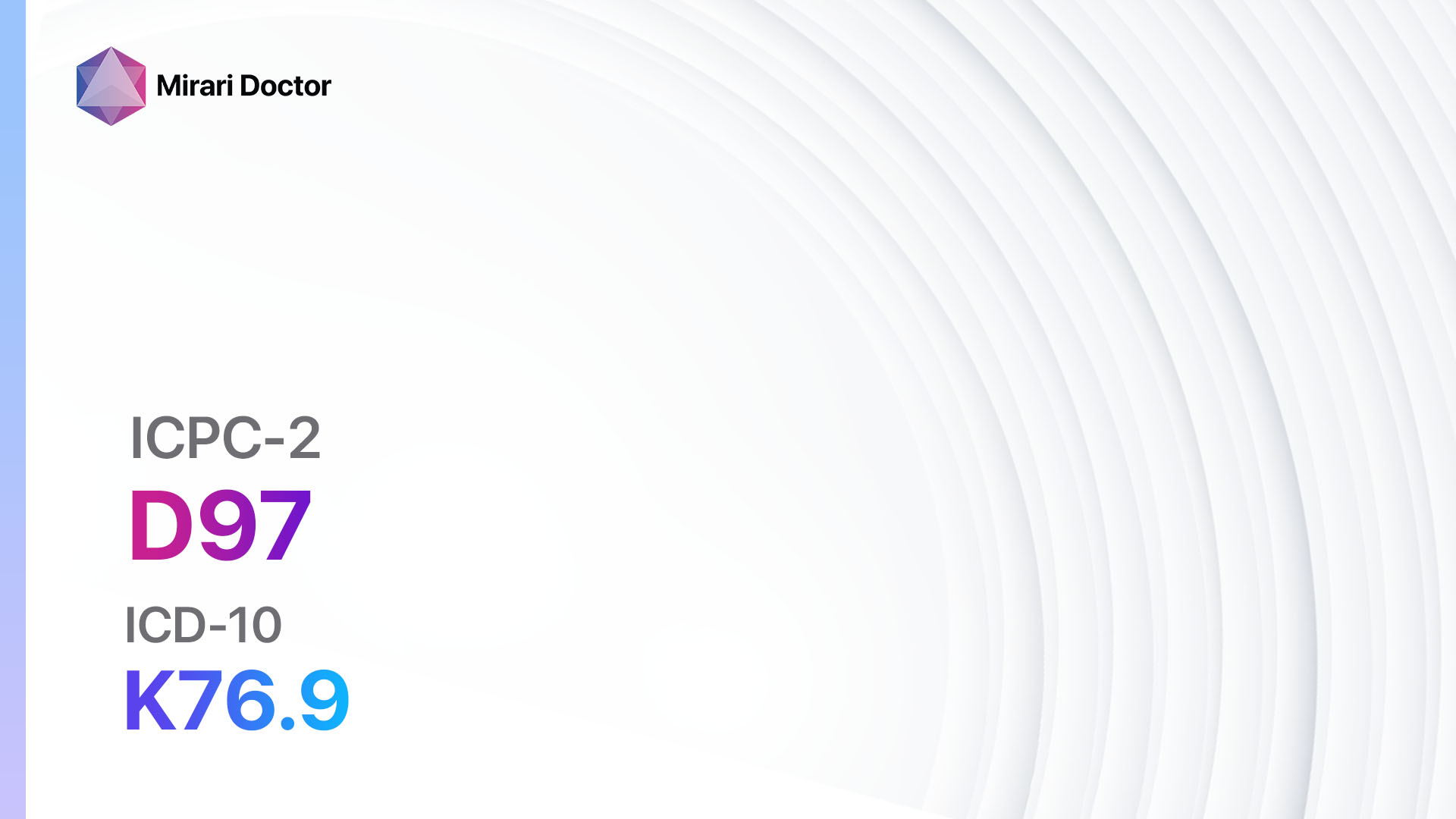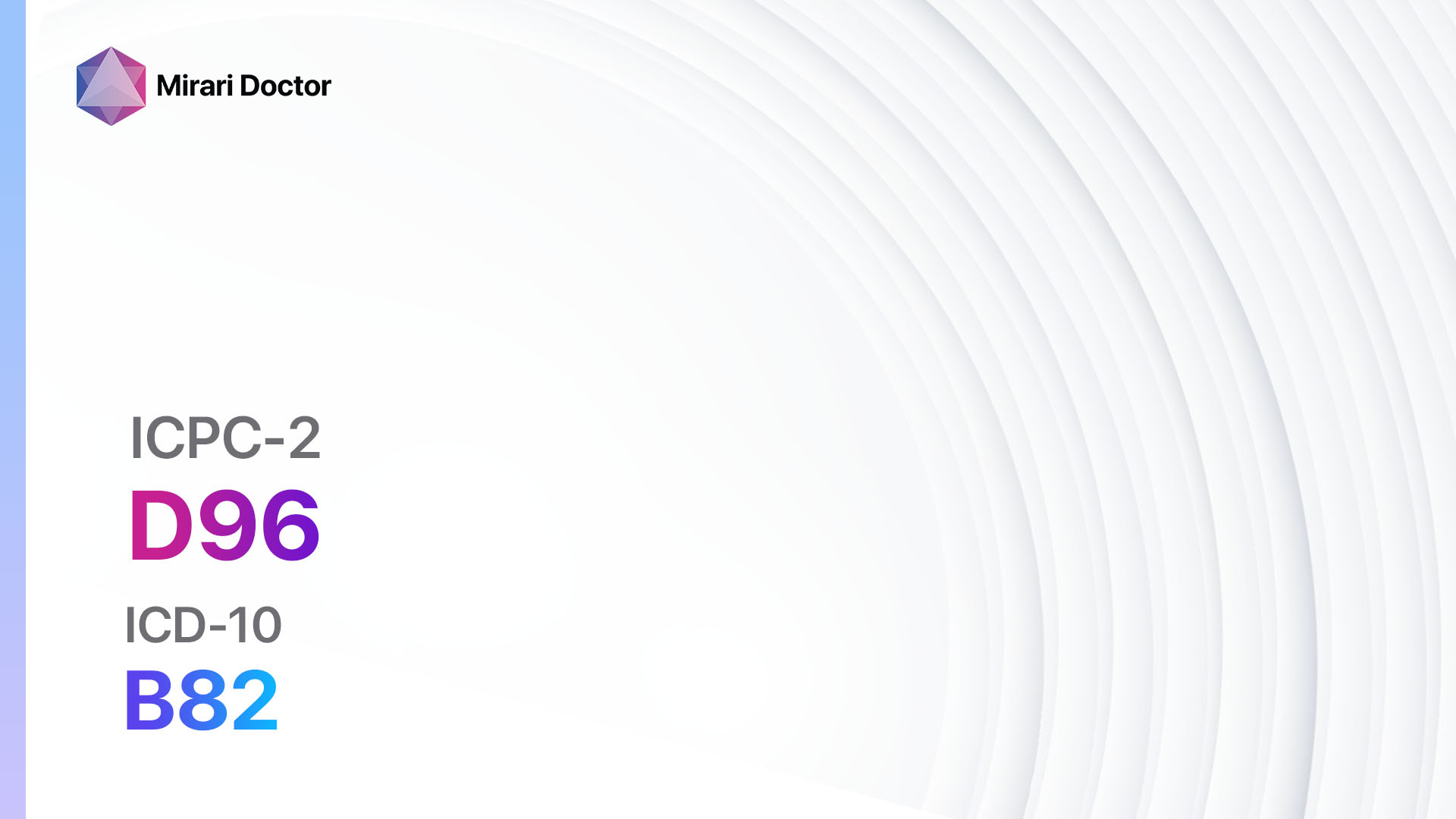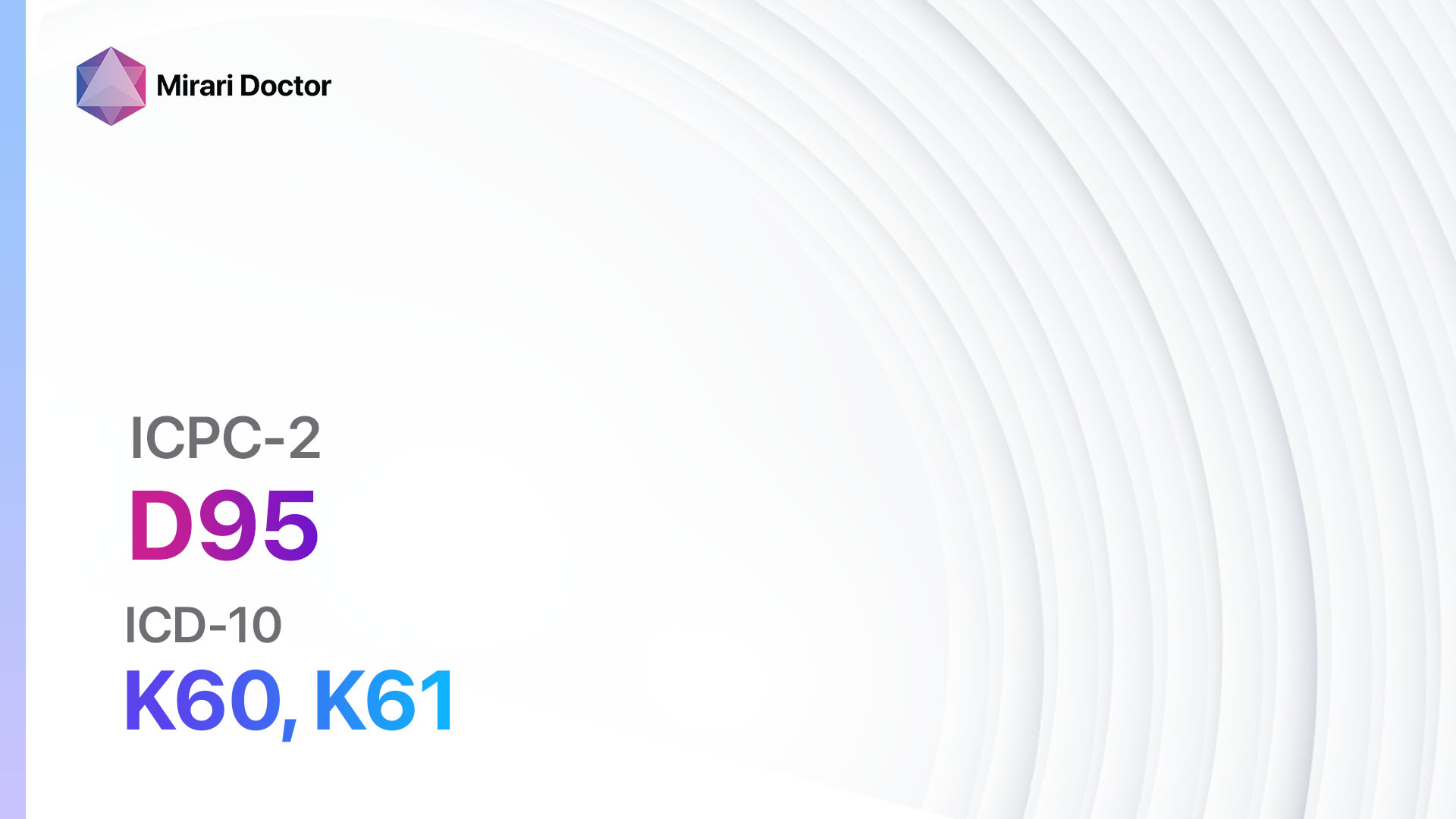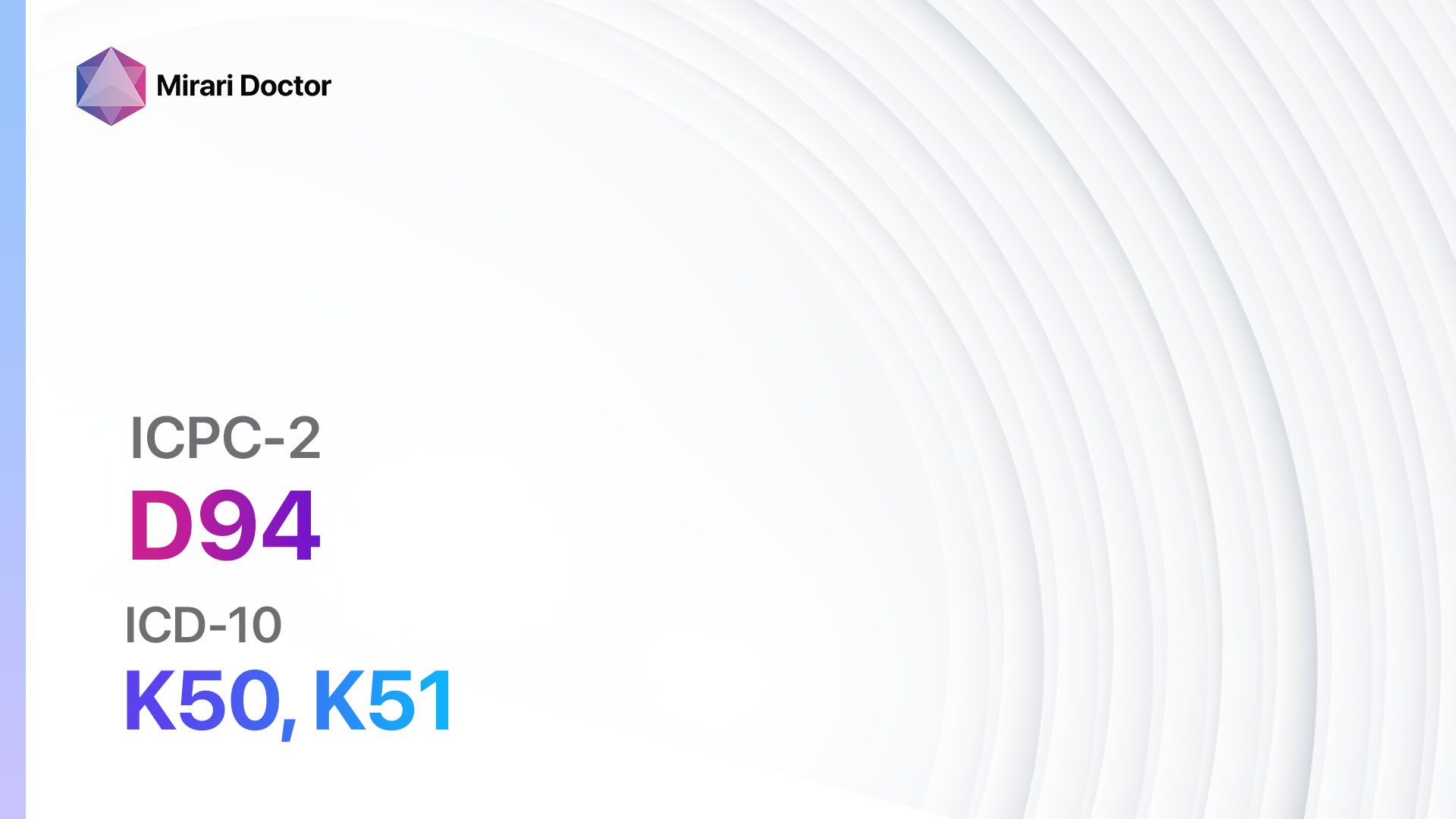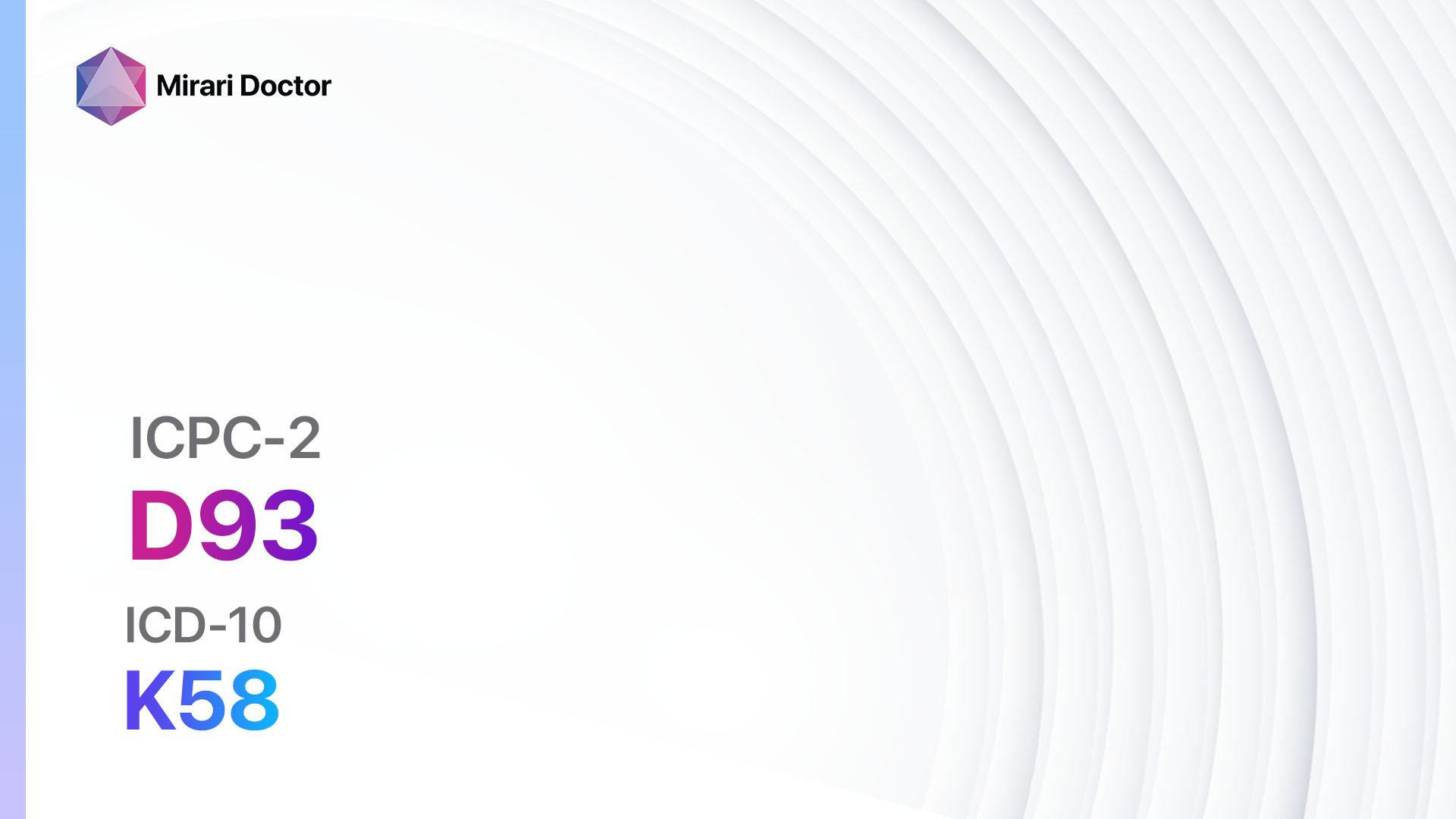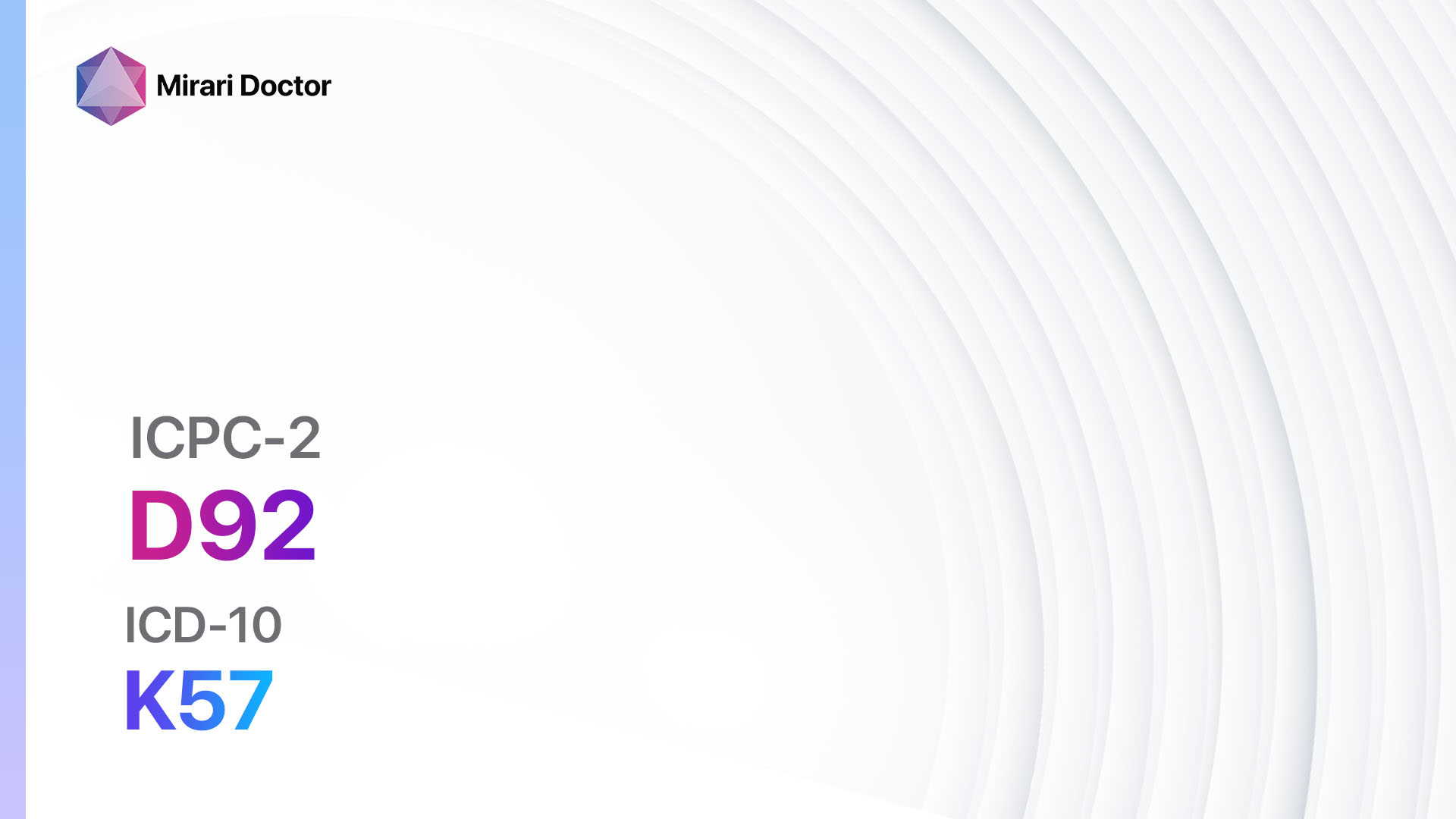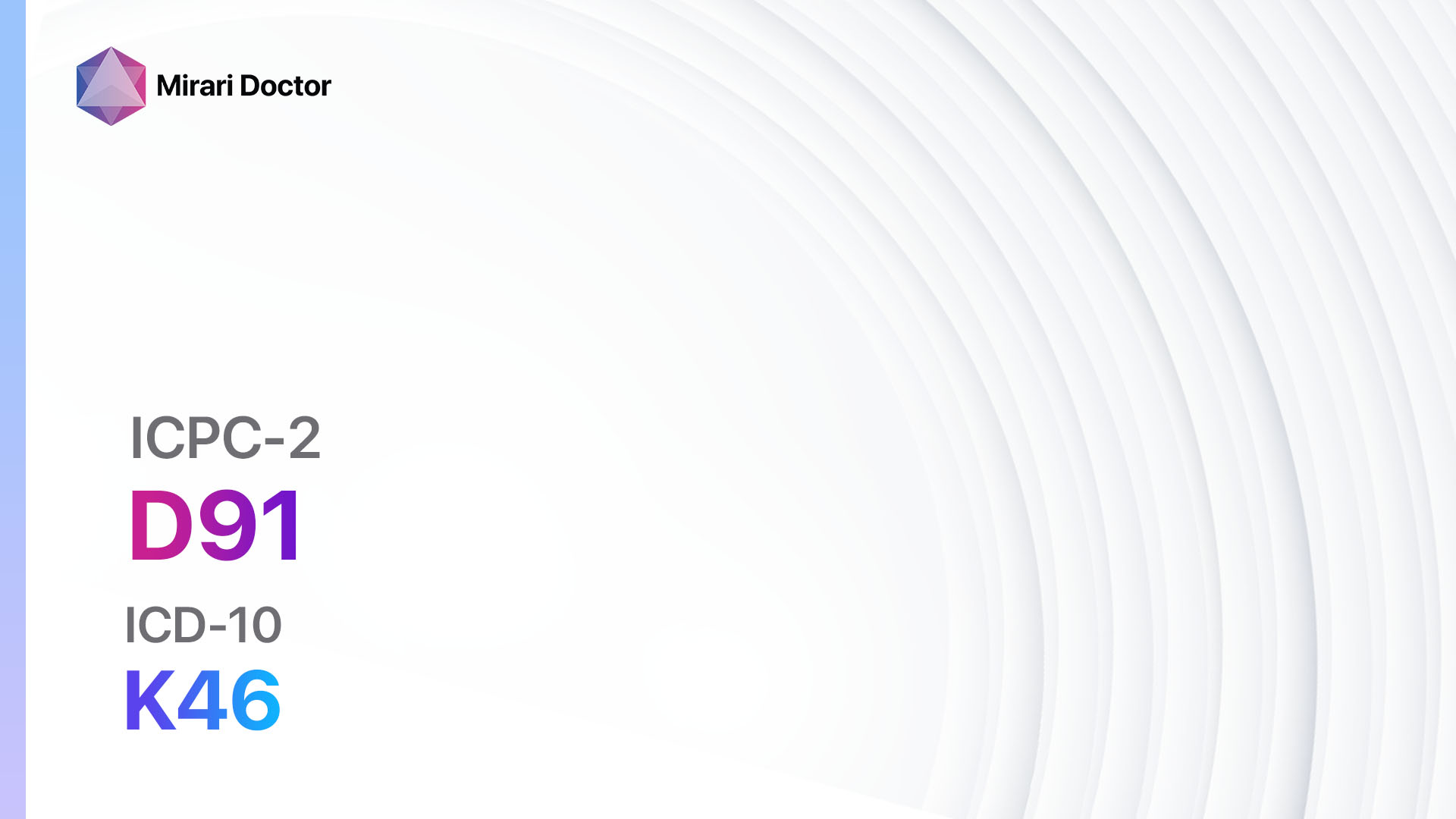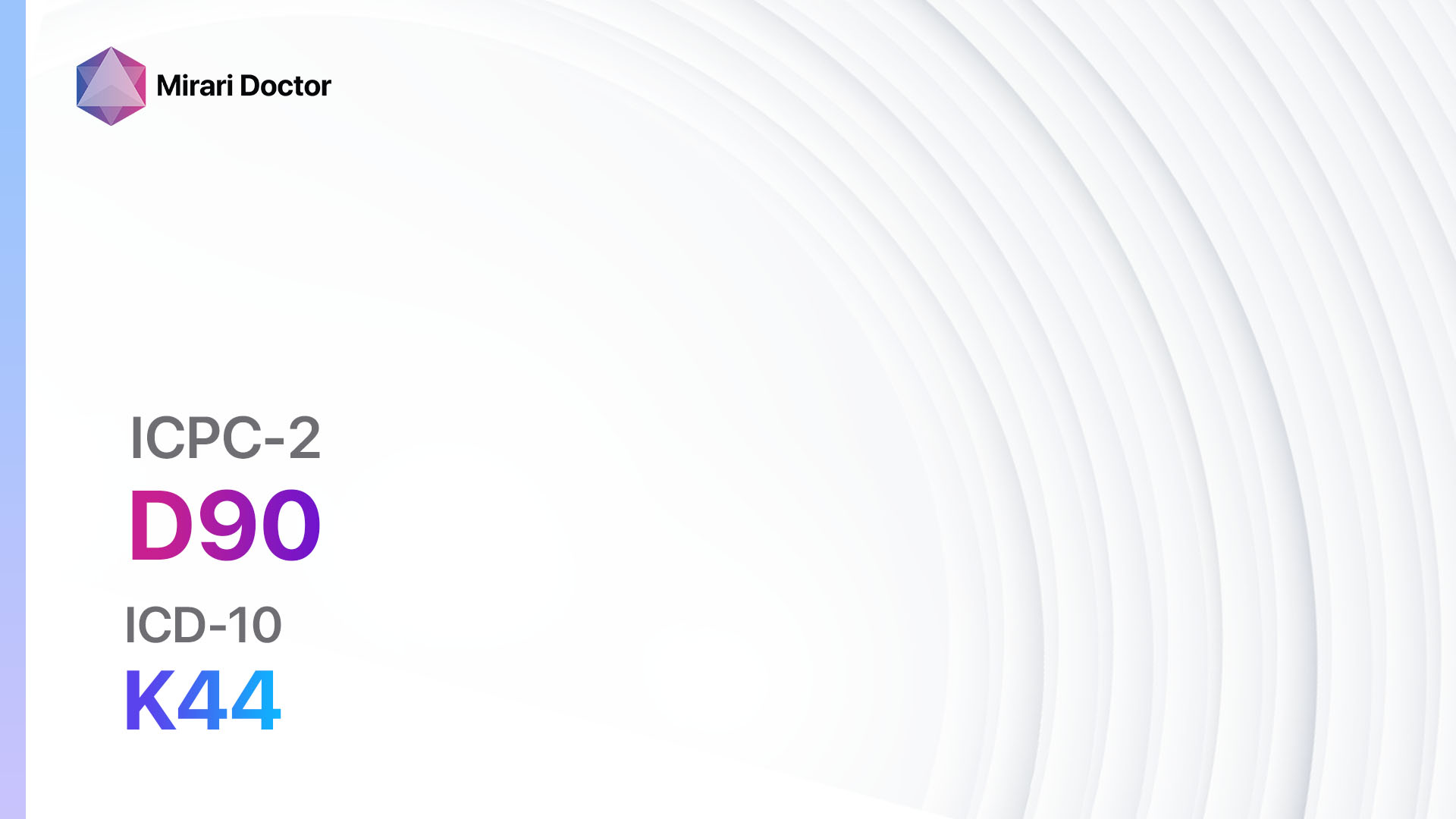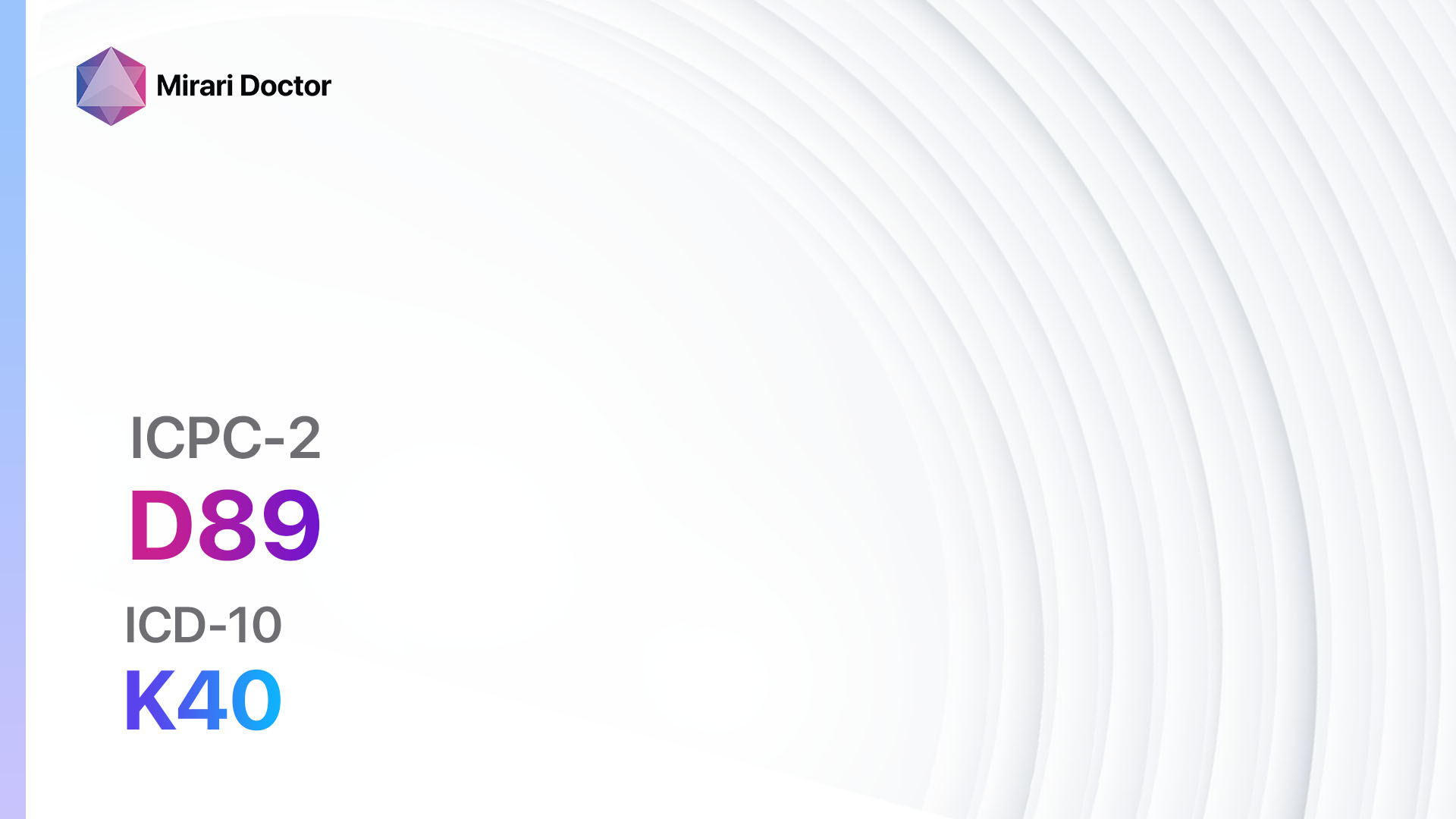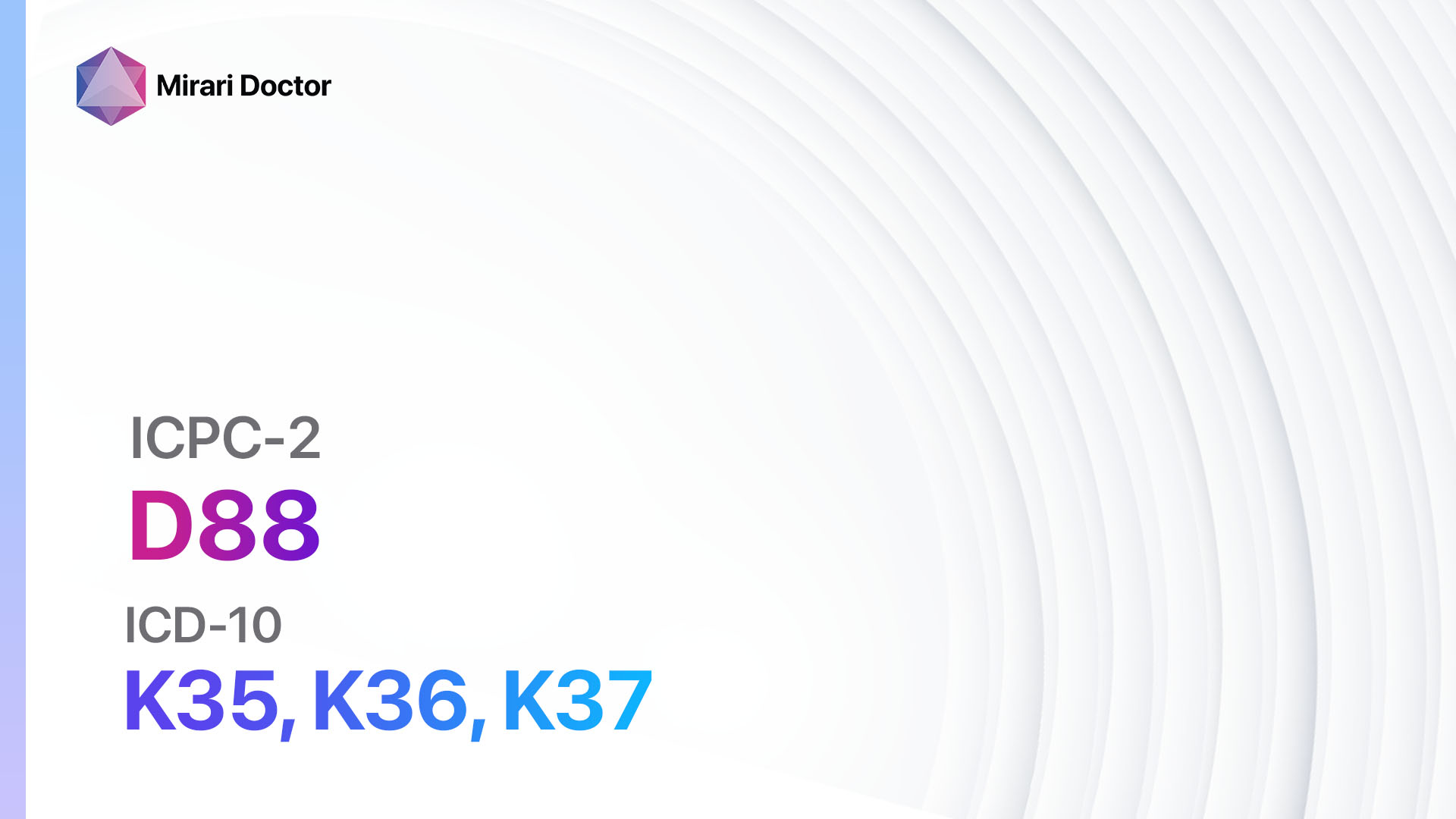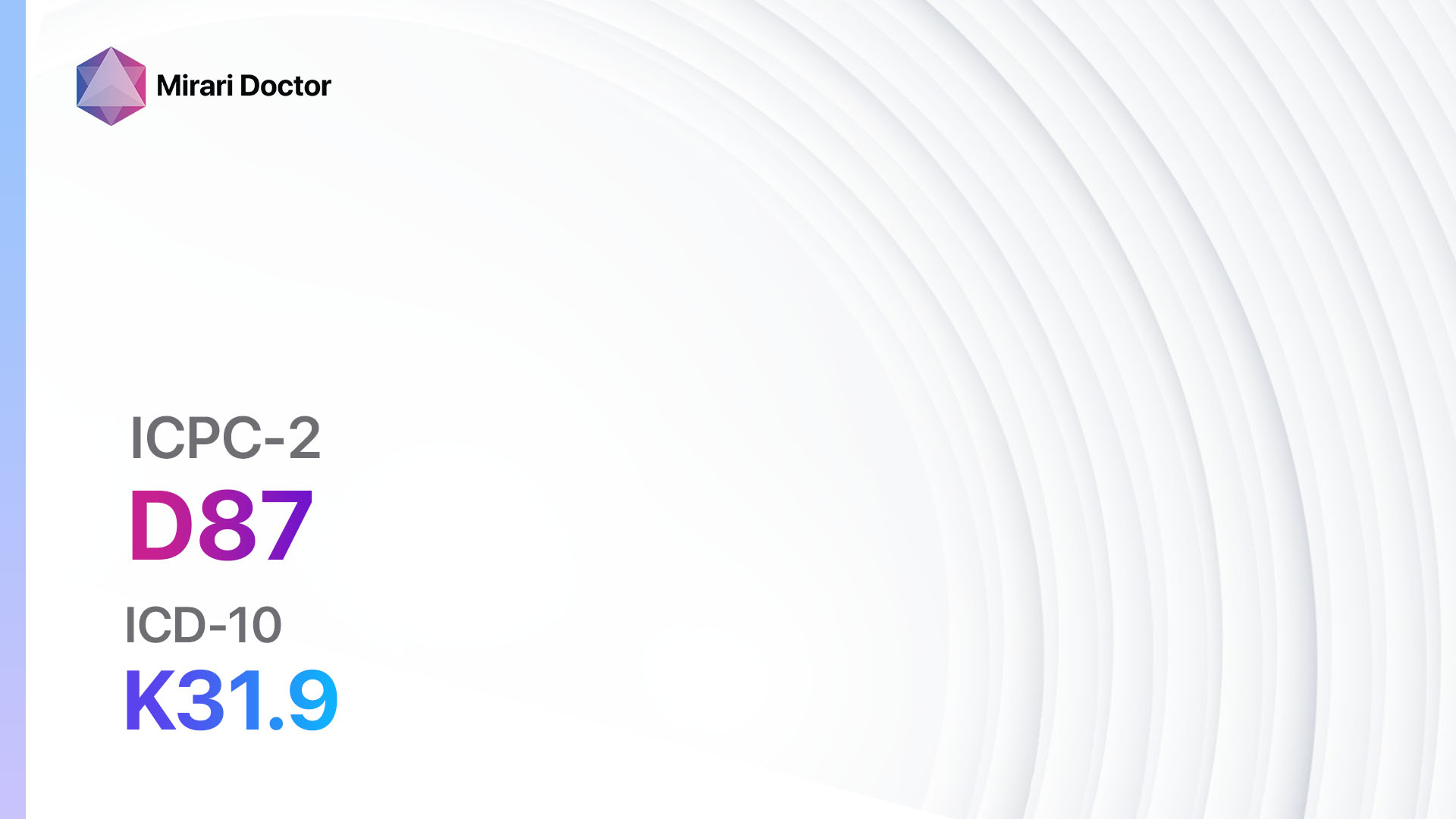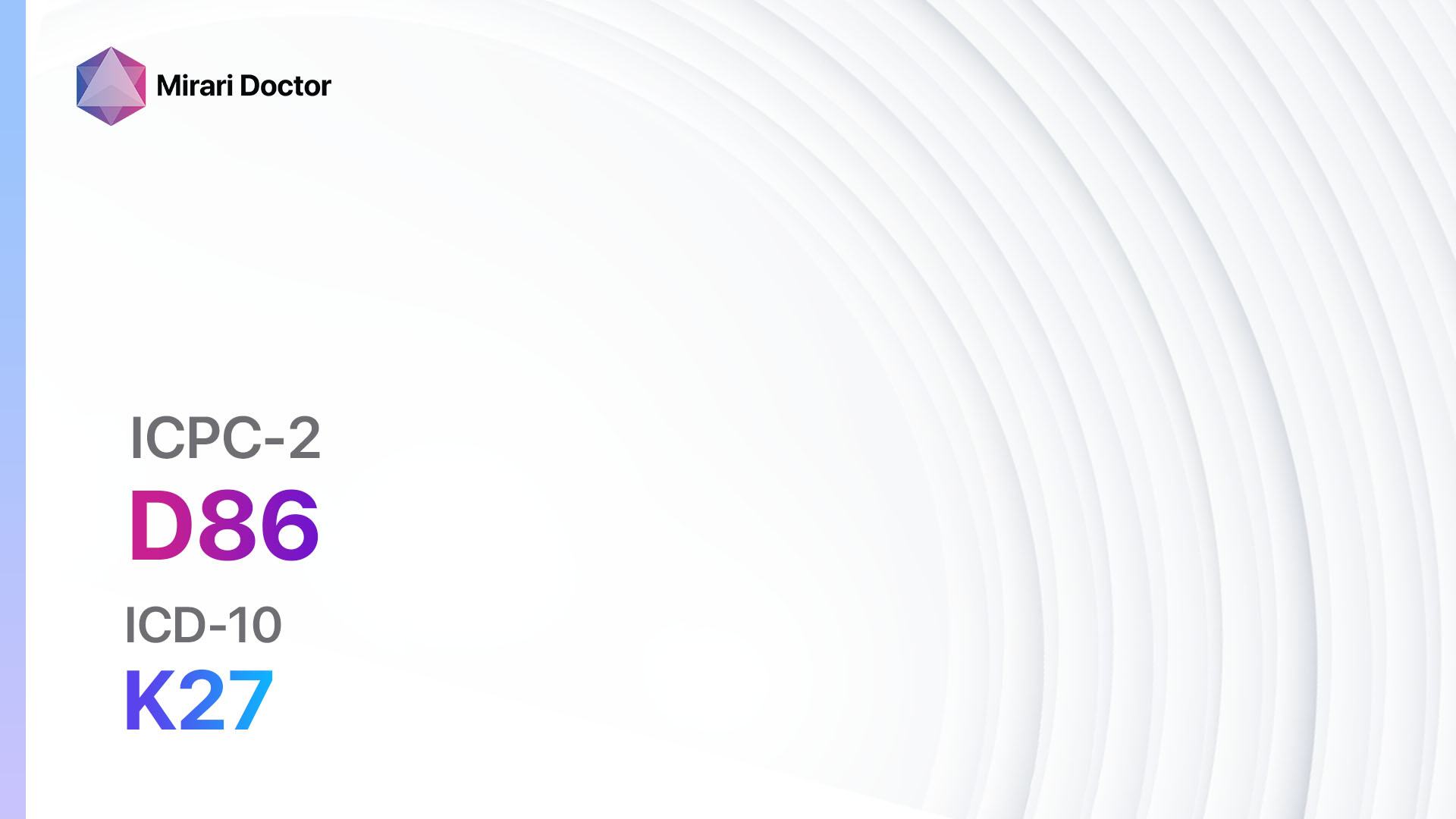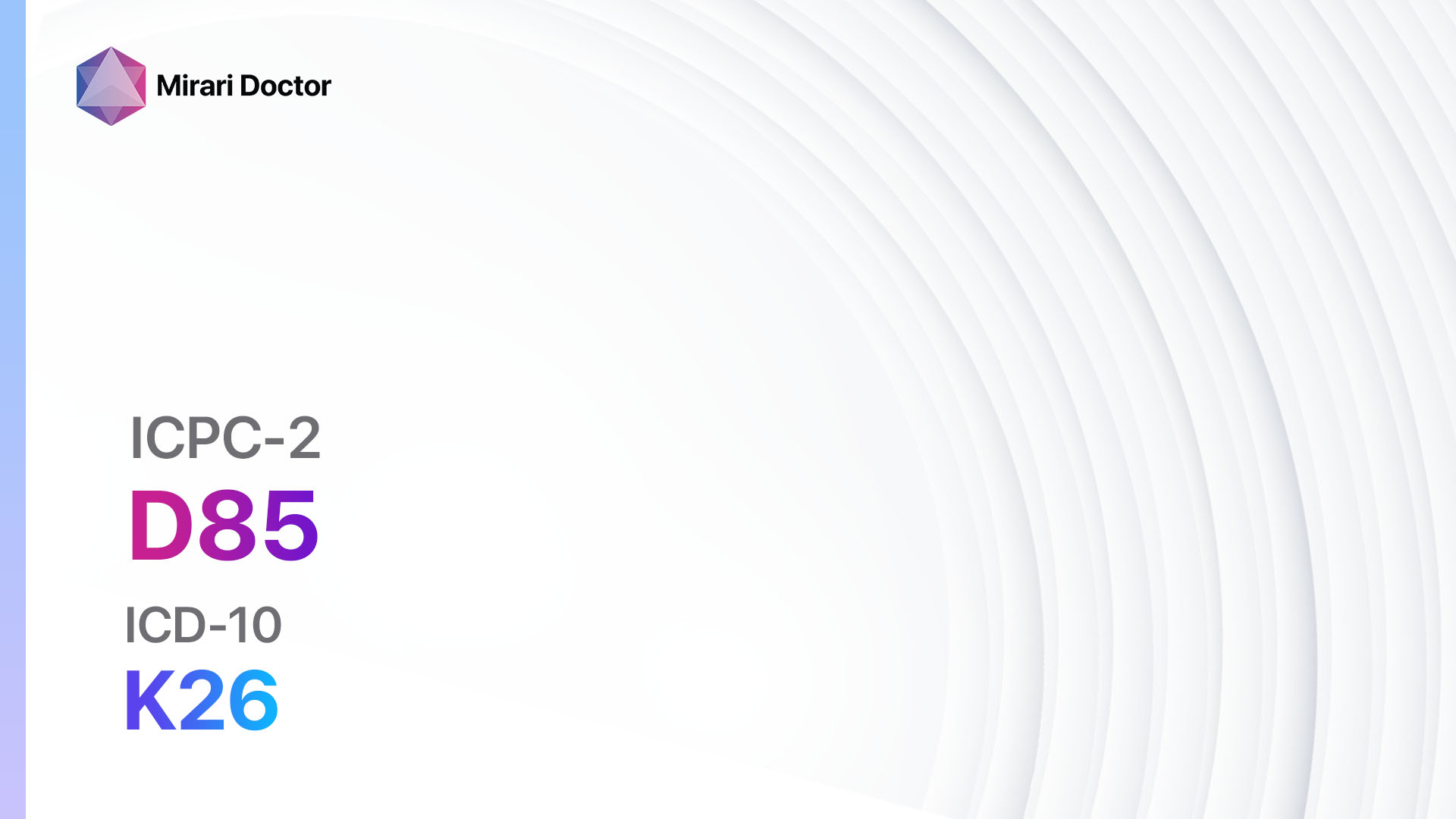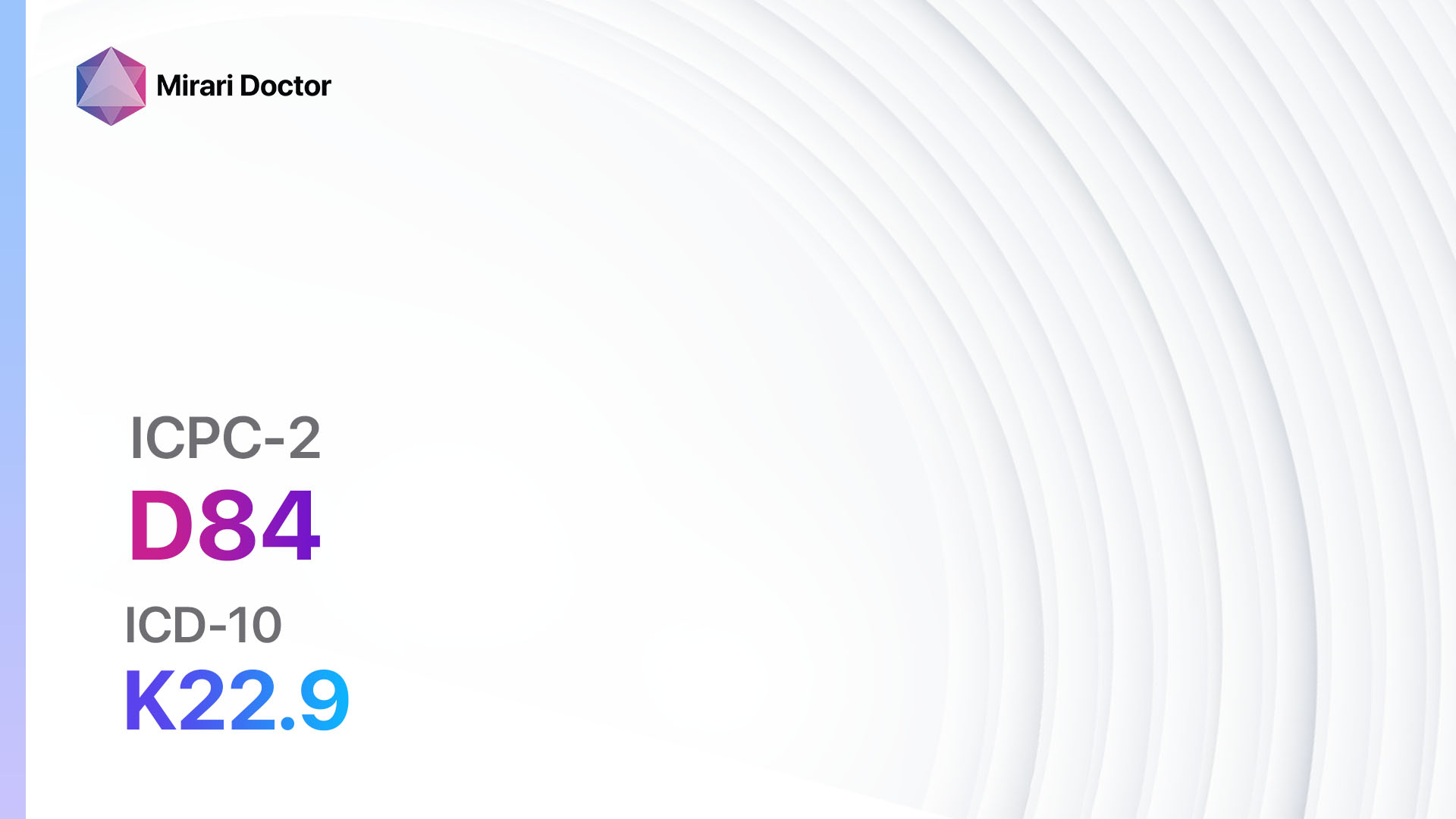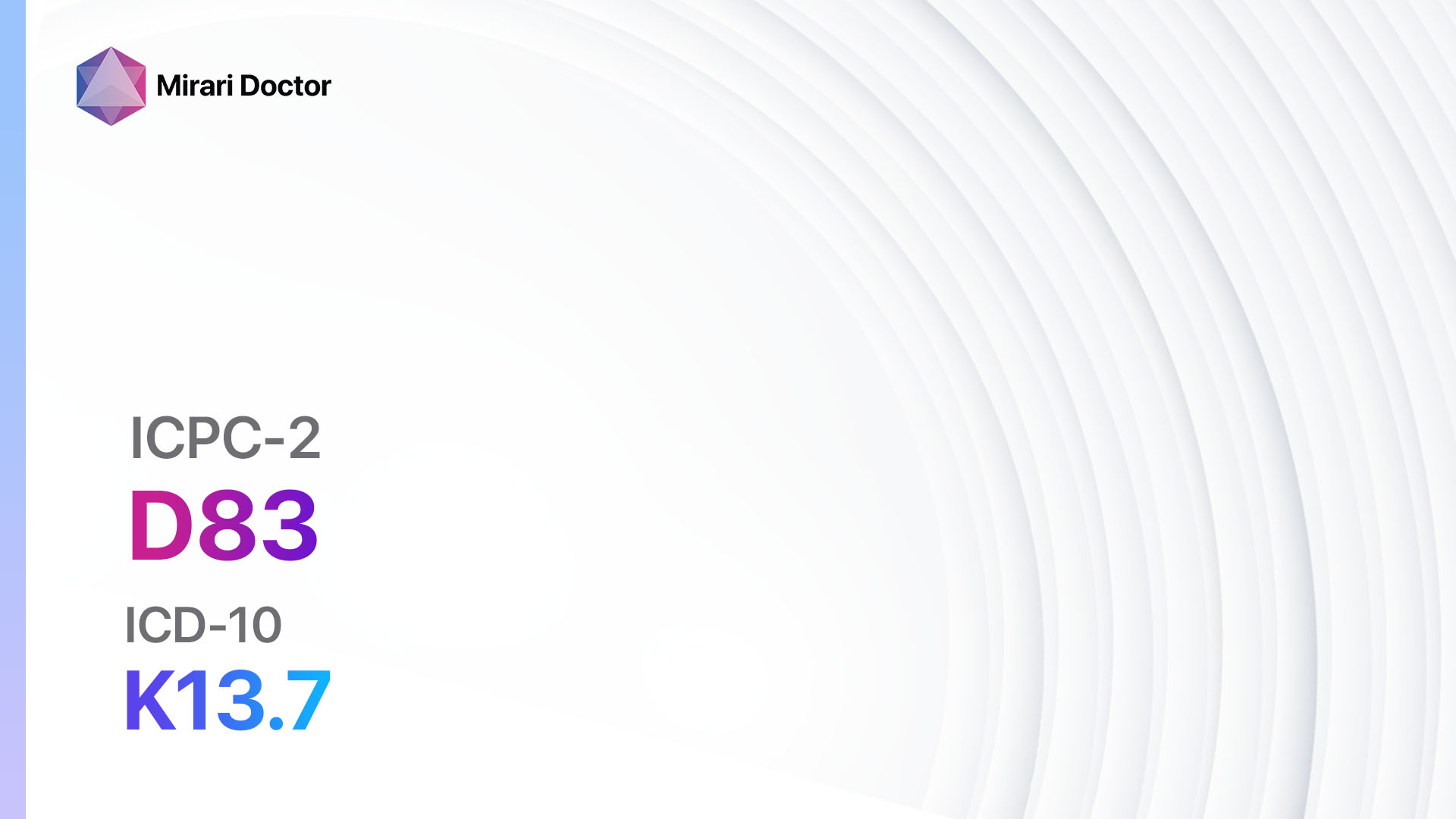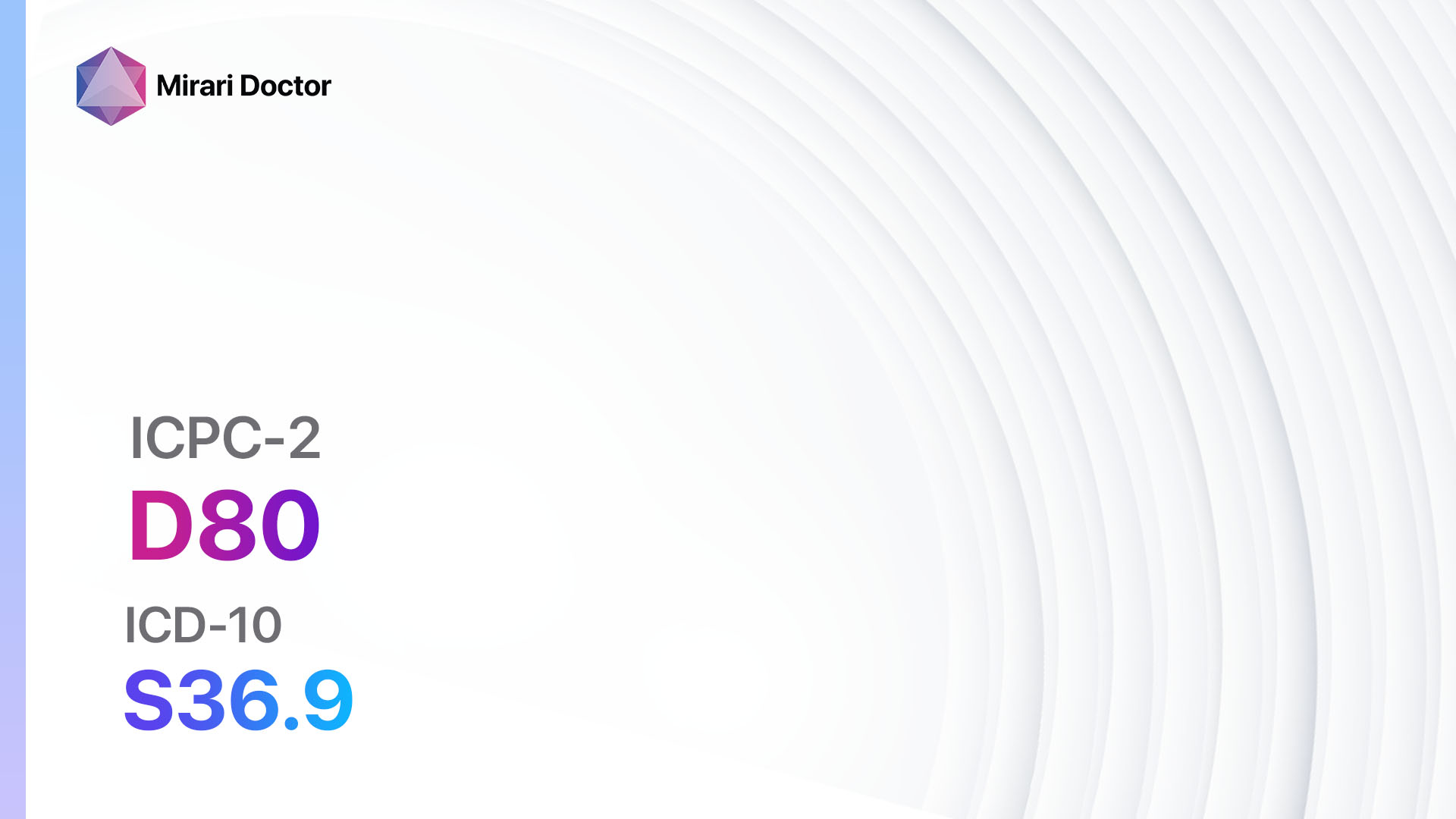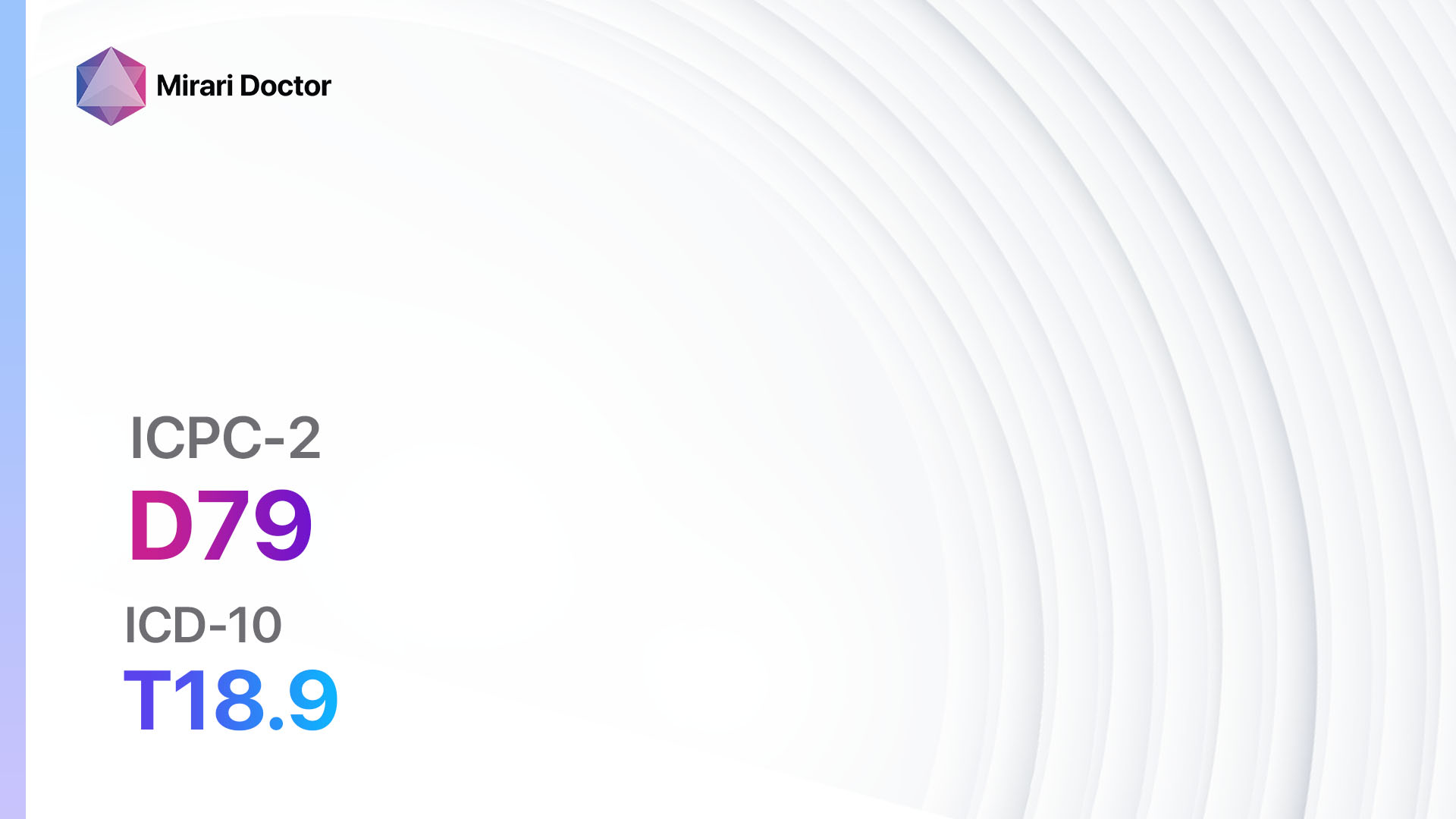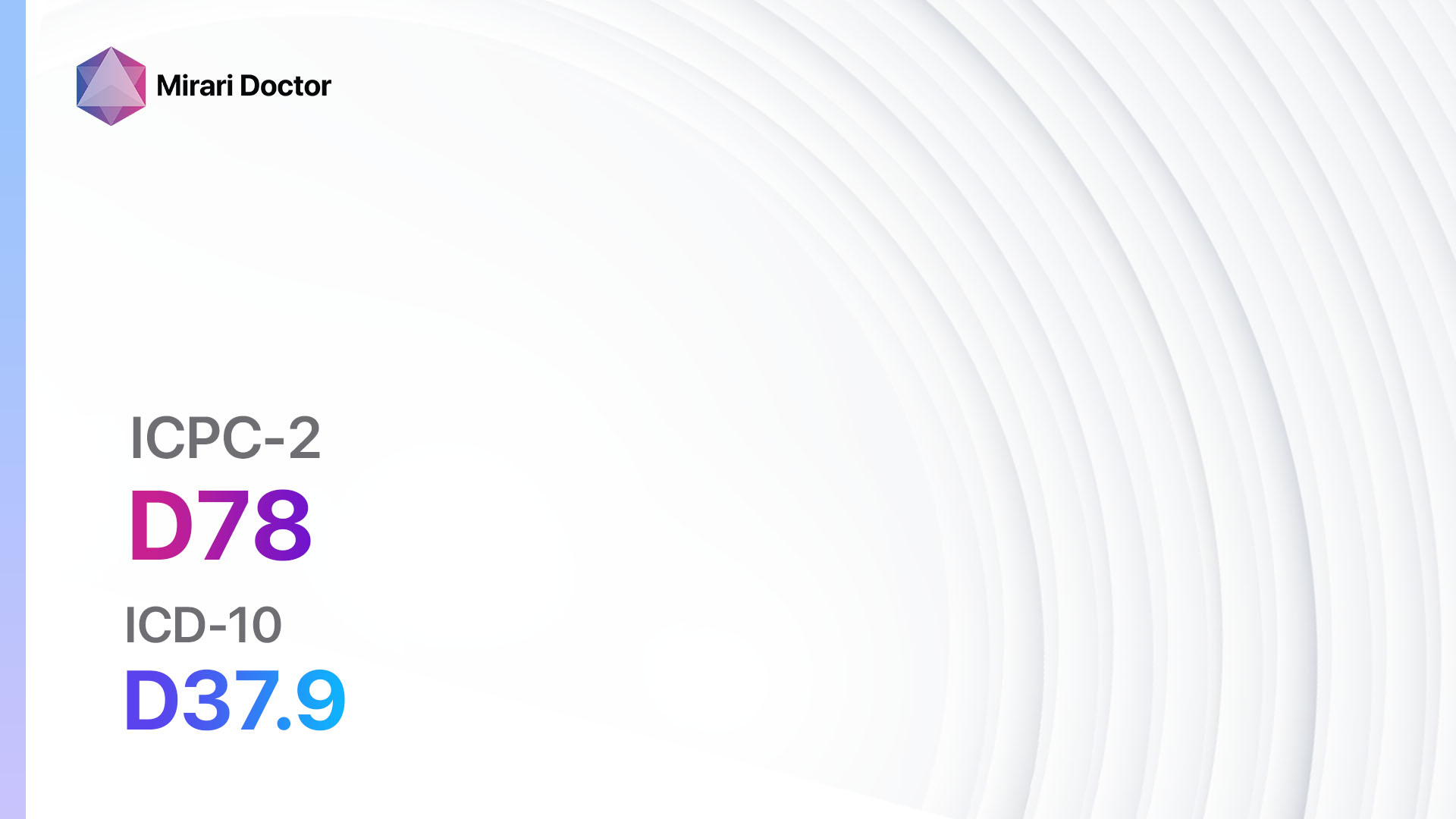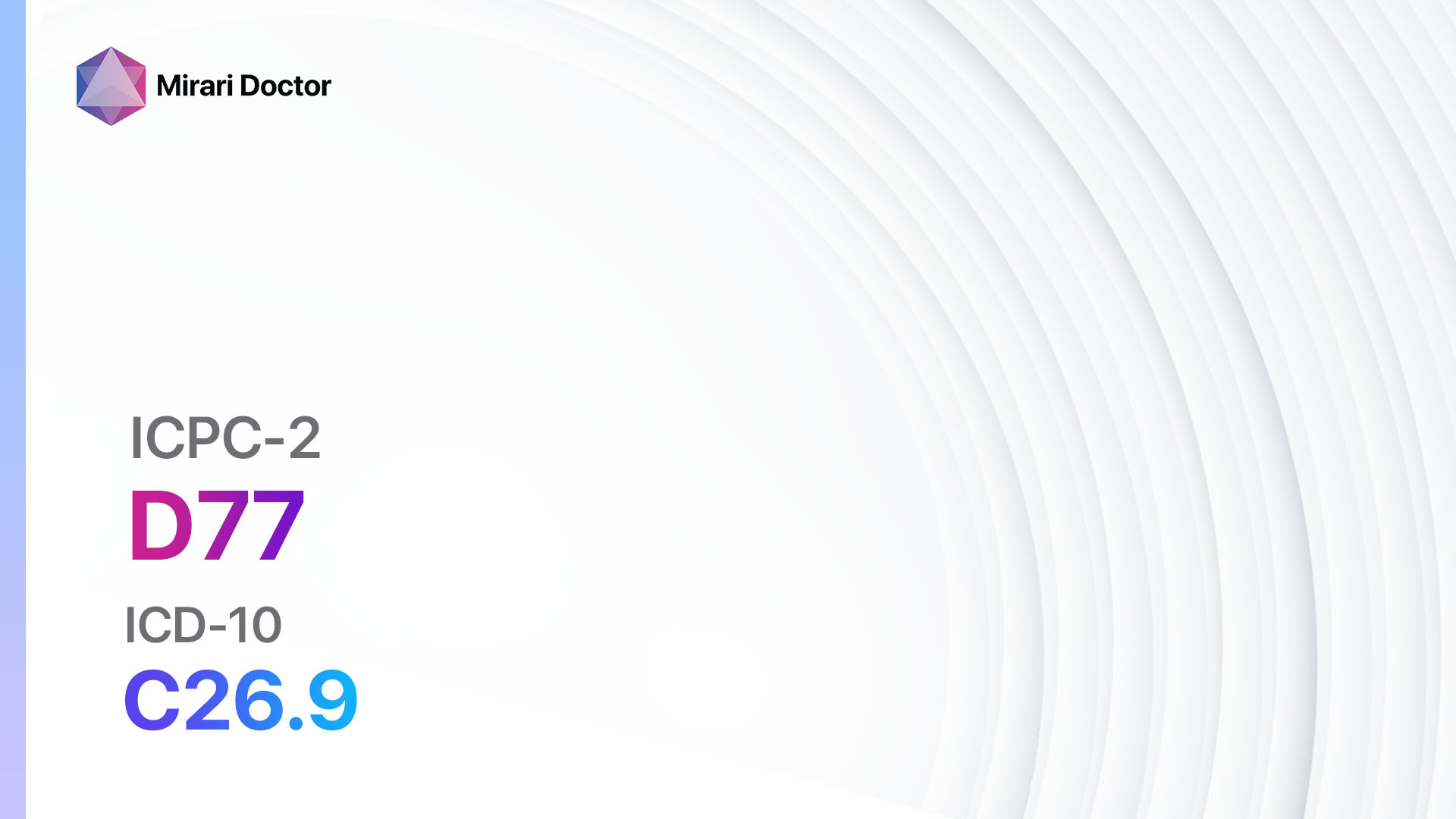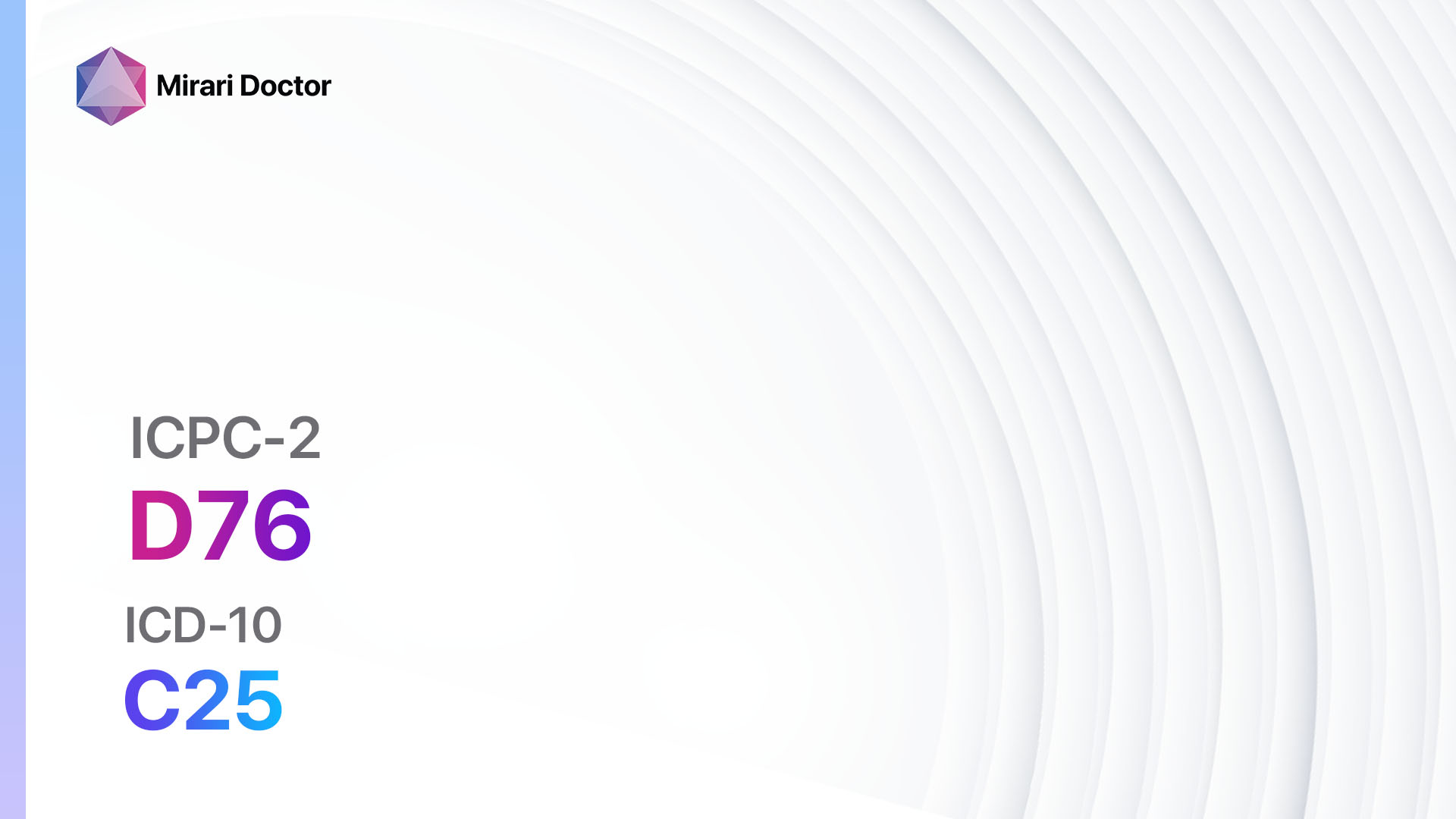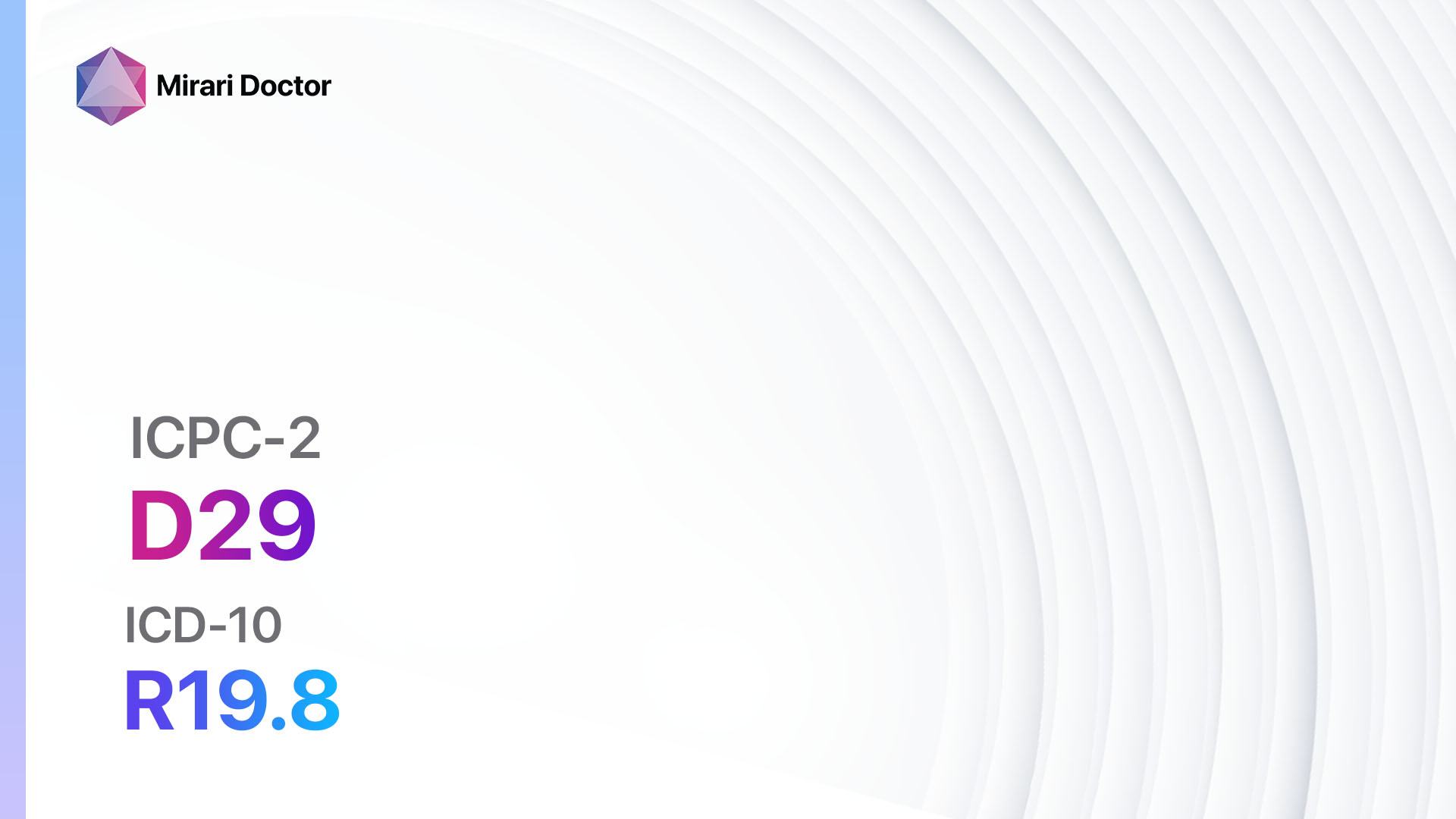
Introduction
Digestive symptoms or complaints that do not fit into specific categories can be challenging to diagnose and treat. This guide aims to provide healthcare professionals with a comprehensive approach to evaluating and managing patients with digestive symptom/complaint other (ICPC-2: D29).[1][2]
Codes
- ICPC-2 Code: D29 Digestive symptom/complaint other[3]
- ICD-10 Code: R19.8 Other specified symptoms and signs involving the digestive system and abdomen[4]
Symptoms
- Abdominal pain: Patients may experience generalized or localized pain in the abdomen.[5]
- Changes in bowel habits: This can include diarrhea, constipation, or alternating between the two.[6]
- Nausea and vomiting: Patients may experience a sensation of nausea and may vomit.[7]
- Bloating and gas: Patients may complain of feeling bloated or having excessive gas.[8]
- Heartburn: Patients may experience a burning sensation in the chest or throat.[9]
- Difficulty swallowing: Patients may have difficulty swallowing food or liquids.[10]
- Weight loss: Unexplained weight loss may be a symptom of underlying digestive issues.
Causes
- Gastrointestinal infections: Bacterial, viral, or parasitic infections can cause digestive symptoms.
- Food intolerances: Certain individuals may have difficulty digesting certain foods, such as lactose or gluten.
- Inflammatory bowel disease: Conditions like Crohn’s disease or ulcerative colitis can cause digestive symptoms.
- Gastroesophageal reflux disease (GERD): Chronic acid reflux can lead to symptoms like heartburn and difficulty swallowing.
- Irritable bowel syndrome (IBS): A chronic condition characterized by abdominal pain and changes in bowel habits.
Diagnostic Steps
Medical History
- Gather information about the patient’s symptoms, including the duration, severity, and any triggers or alleviating factors.
- Ask about the patient’s medical history, including any previous gastrointestinal conditions or surgeries.
- Inquire about the patient’s diet and any recent changes in eating habits.
- Assess for any risk factors, such as a family history of gastrointestinal diseases or exposure to contaminated food or water.
Physical Examination
- Perform a thorough abdominal examination, checking for tenderness, distension, or masses.
- Evaluate the patient’s vital signs, including blood pressure, heart rate, and temperature.
- Look for signs of malnutrition or weight loss.
- Check for any signs of anemia, such as pale conjunctiva or nail beds.
Laboratory Tests
- Complete blood count (CBC): Assess for signs of infection, anemia, or inflammation.
- Stool analysis: Check for the presence of blood, parasites, or bacterial infections.
- Liver function tests: Evaluate liver enzymes and assess liver function.
- Celiac disease serology: Test for antibodies associated with celiac disease.
- Food intolerance testing: Identify any specific food intolerances, such as lactose or gluten intolerance.
Diagnostic Imaging
- Abdominal ultrasound: Visualize the abdominal organs and assess for any abnormalities.
- Upper gastrointestinal series: Evaluate the esophagus, stomach, and small intestine using contrast material.
- Colonoscopy: Examine the colon and rectum for any abnormalities or signs of inflammation.
- CT scan: Provide detailed images of the abdomen and pelvis to identify any structural abnormalities.
- Endoscopy: Insert a flexible tube with a camera into the digestive tract to visualize the esophagus, stomach, and small intestine.
Other Tests
- Breath tests: Assess for conditions like lactose intolerance or small intestinal bacterial overgrowth (SIBO).
- Esophageal manometry: Measure the pressure and movement of the esophagus to evaluate swallowing function.
- pH monitoring: Monitor the acidity levels in the esophagus to diagnose GERD.
- Biopsy: Collect tissue samples for further analysis and to rule out conditions like cancer or inflammatory bowel disease.
Follow-up and Patient Education
- Schedule follow-up appointments to monitor the patient’s progress and adjust treatment plans if necessary.
- Provide education on dietary modifications, including avoiding trigger foods and maintaining a balanced diet.
- Discuss the importance of stress management and lifestyle changes in managing digestive symptoms.
- Address any concerns or questions the patient may have regarding their condition or treatment.
Possible Interventions
Traditional Interventions
Medications:
Top 5 drugs for Digestive symptom/complaint other:
- Proton pump inhibitors (e.g., Omeprazole, Pantoprazole, Esomeprazole):
- Cost: Generic versions can range from $10 to $50/month.
- Contraindications: Hypersensitivity to the medication.
- Side effects: Headache, diarrhea, nausea.
- Severe side effects: Severe allergic reactions, kidney problems.
- Drug interactions: Clopidogrel, methotrexate, digoxin.
- Warning: Long-term use may increase the risk of fractures and certain infections.
- Antispasmodics (e.g., Dicyclomine, Hyoscyamine):
- Cost: Generic versions can range from $10 to $30/month.
- Contraindications: Glaucoma, urinary retention, myasthenia gravis.
- Side effects: Dry mouth, blurred vision, constipation.
- Severe side effects: Severe allergic reactions, rapid heartbeat.
- Drug interactions: Other anticholinergic medications.
- Warning: May cause drowsiness or dizziness.
- Antidiarrheals (e.g., Loperamide, Bismuth subsalicylate):
- Cost: Generic versions can range from $5 to $20/month.
- Contraindications: Severe abdominal pain, bloody diarrhea.
- Side effects: Constipation, stomach cramps.
- Severe side effects: Severe allergic reactions, toxic megacolon (rare).
- Drug interactions: Other medications that slow down gut motility.
- Warning: Not recommended for use in children under 2 years old.
- Antiemetics (e.g., Ondansetron, Metoclopramide):
- Cost: Generic versions can range from $10 to $50/month.
- Contraindications: Bowel obstruction, history of movement disorders.
- Side effects: Headache, dizziness, drowsiness.
- Severe side effects: Irregular heart rhythm, neuroleptic malignant syndrome (rare).
- Drug interactions: Serotonin reuptake inhibitors (SSRIs), dopamine antagonists.
- Warning: Long-term use of metoclopramide may cause a movement disorder called tardive dyskinesia.
- Antacids (e.g., Calcium carbonate, Aluminum hydroxide):
- Cost: Generic versions can range from $5 to $20/month.
- Contraindications: Severe kidney disease, high blood calcium levels.
- Side effects: Constipation (aluminum-based antacids), diarrhea (magnesium-based antacids).
- Severe side effects: Rare but can include kidney stones or kidney damage.
- Drug interactions: Other medications that require stomach acid for absorption.
- Warning: Long-term use may interfere with the absorption of certain nutrients.
Alternative Drugs:
- Probiotics: May help restore the balance of gut bacteria. Cost: Varies depending on the brand and formulation.
- Digestive enzymes: Can aid in the digestion of certain foods. Cost: Varies depending on the specific enzyme and brand.
- Antidepressants: May be prescribed for patients with functional gastrointestinal disorders. Cost: Varies depending on the specific medication and brand.
- Antibiotics: Used to treat bacterial infections that may be causing digestive symptoms. Cost: Varies depending on the specific antibiotic and brand.
- Antispasmodic herbs: Examples include peppermint oil and ginger. Cost: Varies depending on the brand and formulation.
Surgical Procedures:
- Surgery is typically not the first-line treatment for digestive symptom/complaint other. However, in certain cases, surgical intervention may be necessary to address underlying conditions or complications. The cost of surgical procedures can vary significantly depending on the specific procedure, location, and healthcare provider. It is important to discuss the potential risks, benefits, and costs with the patient before considering surgical options.
Alternative Interventions
- Acupuncture: May help alleviate digestive symptoms and promote overall well-being. Cost: $60-$120 per session.
- Herbal supplements: Certain herbs, such as peppermint, ginger, or chamomile, may have soothing effects on the digestive system. Cost: Varies depending on the specific supplement and brand.
- Mind-body techniques: Practices like yoga, meditation, or deep breathing exercises can help reduce stress and improve digestion. Cost: Varies depending on the specific program or class.
- Dietary modifications: Working with a registered dietitian to identify trigger foods and develop a personalized diet plan can be beneficial. Cost: Varies depending on the healthcare provider and insurance coverage.
- Stress management techniques: Engaging in activities like regular exercise, hobbies, or counseling can help reduce stress levels and improve digestive symptoms. Cost: Varies depending on the specific activity or service.
Lifestyle Interventions
- Healthy eating habits: Encourage patients to consume a balanced diet rich in fruits, vegetables, whole grains, and lean proteins. Cost: Varies depending on individual food choices and preferences.
- Hydration: Emphasize the importance of staying hydrated by drinking an adequate amount of water throughout the day. Cost: Varies depending on the availability and cost of clean drinking water.
- Regular physical activity: Encourage patients to engage in regular exercise, such as walking, swimming, or cycling, to promote overall digestive health. Cost: Varies depending on the specific activity or gym membership fees.
- Stress reduction: Recommend stress reduction techniques, such as mindfulness, relaxation exercises, or engaging in enjoyable activities. Cost: Varies depending on the specific technique or activity.
- Adequate sleep: Educate patients about the importance of getting enough sleep to support overall health and digestion. Cost: Varies depending on individual sleep habits and any necessary interventions for sleep disorders.
It is important to note that the cost ranges provided are approximate and may vary depending on the location and availability of the interventions. Healthcare professionals should consider the individual patient’s needs, preferences, and financial situation when recommending interventions.
Mirari Cold Plasma Alternative Intervention
Understanding Mirari Cold Plasma
- Safe and Non-Invasive Treatment: Mirari Cold Plasma is a safe and non-invasive treatment option for various skin conditions. It does not require incisions, minimizing the risk of scarring, bleeding, or tissue damage.
- Efficient Extraction of Foreign Bodies: Mirari Cold Plasma facilitates the removal of foreign bodies from the skin by degrading and dissociating organic matter, allowing easier access and extraction.
- Pain Reduction and Comfort: Mirari Cold Plasma has a local analgesic effect, providing pain relief during the treatment, making it more comfortable for the patient.
- Reduced Risk of Infection: Mirari Cold Plasma has antimicrobial properties, effectively killing bacteria and reducing the risk of infection.
- Accelerated Healing and Minimal Scarring: Mirari Cold Plasma stimulates wound healing and tissue regeneration, reducing healing time and minimizing the formation of scars.
Mirari Cold Plasma Prescription
Video instructions for using Mirari Cold Plasma Device – D29 Digestive symptom/complaint other (ICD-10:R19.8)
| Mild | Moderate | Severe |
| Mode setting: 1 (Infection) Location: 2 (Prostate & Uterus) Morning: 15 minutes, Evening: 15 minutes |
Mode setting: 1 (Infection) Location: 2 (Prostate & Uterus) Morning: 30 minutes, Lunch: 30 minutes, Evening: 30 minutes |
Mode setting: 1 (Infection) Location: 2 (Prostate & Uterus) Morning: 30 minutes, Lunch: 30 minutes, Evening: 30 minutes |
| Mode setting: 2 (Wound Healing) Location: 3 (Kidney, Liver & Spleen) Morning: 15 minutes, Evening: 15 minutes |
Mode setting: 2 (Wound Healing) Location: 3 (Kidney, Liver & Spleen) Morning: 30 minutes, Lunch: 30 minutes, Evening: 30 minutes |
Mode setting: 2 (Wound Healing) Location: 3 (Kidney, Liver & Spleen) Morning: 30 minutes, Lunch: 30 minutes, Evening: 30 minutes |
| Mode setting: 7 (Immunotherapy) Location: 6 (Throat, Lymphatic & Thyroid) Morning: 15 minutes, Evening: 15 minutes |
Mode setting: 7 (Immunotherapy) Location: 6 (Throat, Lymphatic & Thyroid) Morning: 30 minutes, Lunch: 30 minutes, Evening: 30 minutes |
Mode setting: 7 (Immunotherapy) Location: 6 (Throat, Lymphatic & Thyroid) Morning: 30 minutes, Lunch: 30 minutes, Evening: 30 minutes |
| Total Morning: 45 minutes approx. $7.50 USD, Evening: 45 minutes approx. $7.50 USD |
Total Morning: 90 minutes approx. $15 USD, Lunch: 90 minutes approx. $15 USD, Evening: 90 minutes approx. $15 USD, |
Total Morning: 90 minutes approx. $15 USD, Lunch: 90 minutes approx. $15 USD, Evening: 90 minutes approx. $15 USD, |
| Usual treatment for 7-60 days approx. $105 USD – $900 USD | Usual treatment for 6-8 weeks approx. $1,890 USD – $2,520 USD |
Usual treatment for 3-6 months approx. $4,050 USD – $8,100 USD
|
 |
|
Use the Mirari Cold Plasma device to treat Digestive symptom/complaint other effectively.
WARNING: MIRARI COLD PLASMA IS DESIGNED FOR THE HUMAN BODY WITHOUT ANY ARTIFICIAL OR THIRD PARTY PRODUCTS. USE OF OTHER PRODUCTS IN COMBINATION WITH MIRARI COLD PLASMA MAY CAUSE UNPREDICTABLE EFFECTS, HARM OR INJURY. PLEASE CONSULT A MEDICAL PROFESSIONAL BEFORE COMBINING ANY OTHER PRODUCTS WITH USE OF MIRARI.
Step 1: Cleanse the Skin
- Start by cleaning the affected area of the skin with a gentle cleanser or mild soap and water. Gently pat the area dry with a clean towel.
Step 2: Prepare the Mirari Cold Plasma device
- Ensure that the Mirari Cold Plasma device is fully charged or has fresh batteries as per the manufacturer’s instructions. Make sure the device is clean and in good working condition.
- Switch on the Mirari device using the power button or by following the specific instructions provided with the device.
- Some Mirari devices may have adjustable settings for intensity or treatment duration. Follow the manufacturer’s instructions to select the appropriate settings based on your needs and the recommended guidelines.
Step 3: Apply the Device
- Place the Mirari device in direct contact with the affected area of the skin. Gently glide or hold the device over the skin surface, ensuring even coverage of the area experiencing.
- Slowly move the Mirari device in a circular motion or follow a specific pattern as indicated in the user manual. This helps ensure thorough treatment coverage.
Step 4: Monitor and Assess:
- Keep track of your progress and evaluate the effectiveness of the Mirari device in managing your Digestive symptom/complaint other. If you have any concerns or notice any adverse reactions, consult with your health care professional.
Note
This guide is for informational purposes only and should not replace the advice of a medical professional. Always consult with your healthcare provider or a qualified medical professional for personal advice, diagnosis, or treatment. Do not solely rely on the information presented here for decisions about your health. Use of this information is at your own risk. The authors of this guide, nor any associated entities or platforms, are not responsible for any potential adverse effects or outcomes based on the content.
Mirari Cold Plasma System Disclaimer
- Purpose: The Mirari Cold Plasma System is a Class 2 medical device designed for use by trained healthcare professionals. It is registered for use in Thailand and Vietnam. It is not intended for use outside of these locations.
- Informational Use: The content and information provided with the device are for educational and informational purposes only. They are not a substitute for professional medical advice or care.
- Variable Outcomes: While the device is approved for specific uses, individual outcomes can differ. We do not assert or guarantee specific medical outcomes.
- Consultation: Prior to utilizing the device or making decisions based on its content, it is essential to consult with a Certified Mirari Tele-Therapist and your medical healthcare provider regarding specific protocols.
- Liability: By using this device, users are acknowledging and accepting all potential risks. Neither the manufacturer nor the distributor will be held accountable for any adverse reactions, injuries, or damages stemming from its use.
- Geographical Availability: This device has received approval for designated purposes by the Thai and Vietnam FDA. As of now, outside of Thailand and Vietnam, the Mirari Cold Plasma System is not available for purchase or use.
References
- Sjtrem.biomedcentral.com. 2012. Structured classification for ED presenting complaints – from free text field-based approach to ICPC-2 ED application. [online] Available at: https://sjtrem.biomedcentral.com/articles/10.1186/1757-7241-20-76/tables/4 [Accessed 8 June 2024].
- Unboundmedicine.com. 2024. R19.8 – Other specified symptoms and signs involving the digestive system and abdomen. [online] Available at: https://www.unboundmedicine.com/icd/view/ICD-10-CM/913572/all/R19_8___Other_specified_symptoms_and_signs_involving_the_digestive_system_and_abdomen [Accessed 8 June 2024].
- Biomerieux.com. 2024. Gastrointestinal Infection Solutions & Testing – BioMerieux. [online] Available at: https://www.biomerieux.com/corp/en/our-offer/hospital-laboratory/patient-condition/gastrointestinal-infection-solutions-and-testing.html [Accessed 8 June 2024].
- Ncbi.nlm.nih.gov. 2024. Health complaints in individual visiting primary health care – NCBI. [online] Available at: https://www.ncbi.nlm.nih.gov/pmc/articles/PMC9008379/ [Accessed 8 June 2024].
- Aapc.com. 2024. ICD-10 code R19 for Other symptoms and signs involving … – AAPC. [online] Available at: https://www.aapc.com/codes/icd-10-codes/R19 [Accessed 8 June 2024].
- Health.com. 2024. Gastrointestinal Infection: Symptoms, Causes, Treatment – Health. [online] Available at: https://www.health.com/condition/gastrointestinal-infections-overview [Accessed 8 June 2024].
- Abs.gov.au. 2024. 4363.0.55.001 – National Health Survey: Users’ Guide, 2001. [online] Available at: https://www.abs.gov.au/ausstats/abs%40.nsf/2f762f95845417aeca25706c00834efa/1dd0d209004529adca256d32001d138f!OpenDocument [Accessed 8 June 2024].
- Aapc.com. 2024. ICD-10-CM Code for Other specified symptoms and signs involving …. [online] Available at: https://www.aapc.com/codes/icd-10-codes/R19.8 [Accessed 8 June 2024].
- Healthline.com. 2024. Gastrointestinal Infection: Symptoms, Causes, and Treatment. [online] Available at: https://www.healthline.com/health/gastrointestinal-infection [Accessed 8 June 2024].
- Referentiemodel.nhg.org. 2024. [PDF] NHG-Tabel-78 ICPC-1 NL-Engels-versie 1-Inkijkexemplaar. [online] Available at: https://referentiemodel.nhg.org/sites/default/files/public/NHG-Tabel%2078-ICPC-1%20NL-Engels-versie%201-Inkijkexemplaar.pdf [Accessed 8 June 2024].
Related articles
Made in USA


